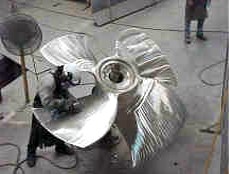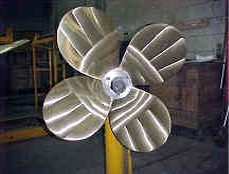Properties of Bronze for Marine Propellers
COMPARATIVE SERVICE DATA. The superiority of nickel aluminum bronze has been convincingly demonstrated by an in-service test.
One propeller of each material was installed on a 6,000 ton twin screw carrier, which subjects its wheels to unusually severe service by operating on the Orinoco River in Venezuela.
The sand bars and sand in suspension in this river are responsible for damage to the ship’s propellers, needing frequent reconditioning or replacement.
The nickel aluminum bronze (starboard) propeller has suffered little mechanical damage or erosion, while the manganese bronze (port) propeller was rather severely damaged and required frequent repair.
The U.S. Navy is using nickel aluminum bronze material for propellers for ice-breaking service, and after a full season of operation excellent results were noted.
Propeller efficiency. Less obvious perhaps than the data presented in Table 1, but more important from a service standpoint, is propeller efficiency. The design engineers are most impressed by the ability of nickel aluminum bronze to retain its original smooth machined surface over a long period of time, thereby retaining its high efficiency factor. Numerically the improvement in efficiency would lie in the order of 1.5-3.0 per cent, with resultant fuel savings. The exact efficiency increase would depend upon the propeller size, design factors and length of service.
Design Benefit. As nickel aluminum bronze is in itself approximately 10 per cent lighter in weight than manganese bronze, and can be designed to thinner sections because of its higher strength, other advantages become apparent. For example, loading stresses on the tailshaft and bearings are reduce, thus permitting smaller shafts.
Resistance to Notch Sensitivity. The ability of nickel aluminum bronze to resist failure under impact when notched, contributes greatly to its value as a propeller material.
Maintenance. Maintenance of nickel aluminum bronze propellers is greatly reduced compared to that of manganese bze it has superior resistance to bending, breaking and wearing, including cavitation are directly associated with the material properties.
Reparability. Nickel aluminum bronze is readily reparable with the inert gas process, or by direct electric rod welding. Little or no pre-heat is required, and unlike to copper-zinc brasses, it is not subject to stress corrosion cracking and therefore does not necessarily require a stress relief treatment.
Propeller cost. Reduced weight of nickel aluminum bronze in conjunction with increased strength of the material allows designing the propeller approximately 15 % less in weight than a comparable manganese bze propeller. Although the former is more costly by the price per pound, the long term cost reduction is appreciable.
TABLE 1 - TEST RESULTS OF NICKEL ALUMINUM AND MANGANESE BRONZE
| Item | Nickel Aluminum Bronze | Manganese Bronze |
Chemical composition %
| Copper | 78 - 81 | 55 – 60 |
| Zinc | In “all others” | Reminder |
| Nickel | 4.5 - 5.5 | - |
| Iron | 3.5 –5.5 | 0.9 – 2.0 |
| Manganese | 0.5 – 1.0 | 0.3 – 0.9 |
| Aluminum | 9.0 – 10.3 | 0.7 – 1.0 |
| Lead | 0.01 max | 0.4 max |
| Tin | In “all others” | 1.5 max |
| All Others | 0.5 max | - |
Mechanical Properties (Normal Range)
| Yield | 35 – 43,000 psi | 27 – 33,000 psi |
| Tensile | 80 - 95,000 psi | 60 - 72,000 psi |
| % Elong in 2 in | 15 – 30 | 20 – 35 |
| Proof stress | 28,000 psi | 14 – 16,000 psi |
| Brinell hardness | 152 – 190 | 112 – 130 |
| Fatigue – air | 21 – 25,000 psi | 9 – 14,000 psi |
| Fatigue – salt water | 18 – 22,000 psi | 9 – 12,500 psi |
| Density – lb/cu in | 0.273 | 0.297 |
Spin Test
| Weight loss – grams | 2.48 | 9.21 |
| Loss – Mg/in2/day Mg/dm2/day | 6.5 99.0 | 24.0 376.0 |
| In penetration/yr | 0.019 | 0.063 |
| At tip – in | 0.005 | 0.012 |
 Propellers of nickel aluminum bronze |  Propellers of manganese bronze |
No comments:
Post a Comment